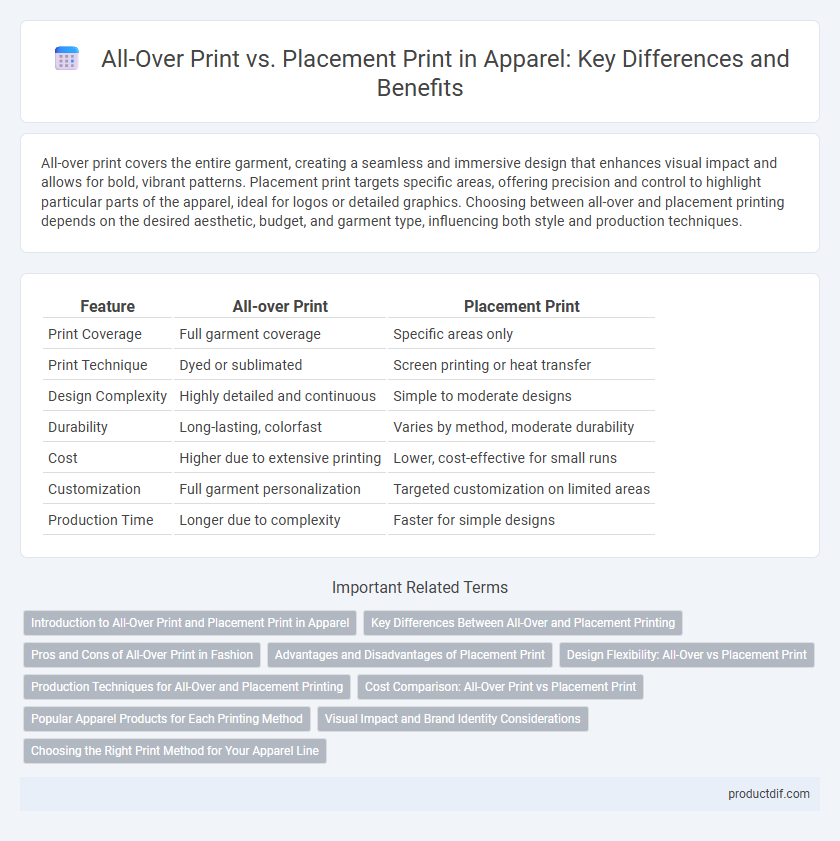All-over print covers the entire garment, creating a seamless and immersive design that enhances visual impact and allows for bold, vibrant patterns. Placement print targets specific areas, offering precision and control to highlight particular parts of the apparel, ideal for logos or detailed graphics. Choosing between all-over and placement printing depends on the desired aesthetic, budget, and garment type, influencing both style and production techniques.
Table of Comparison
| Feature | All-over Print | Placement Print |
|---|---|---|
| Print Coverage | Full garment coverage | Specific areas only |
| Print Technique | Dyed or sublimated | Screen printing or heat transfer |
| Design Complexity | Highly detailed and continuous | Simple to moderate designs |
| Durability | Long-lasting, colorfast | Varies by method, moderate durability |
| Cost | Higher due to extensive printing | Lower, cost-effective for small runs |
| Customization | Full garment personalization | Targeted customization on limited areas |
| Production Time | Longer due to complexity | Faster for simple designs |
Introduction to All-Over Print and Placement Print in Apparel
All-over print in apparel covers the entire garment surface with continuous patterns or designs, providing vibrant and seamless visuals ideal for bold, eye-catching styles. Placement print targets specific areas of the clothing, allowing precise control over design location, commonly used for logos and detailed graphics. Both printing methods offer unique customization options that enhance garment aesthetics and brand identity.
Key Differences Between All-Over and Placement Printing
All-over printing covers the entire garment with a continuous design, ensuring seamless patterns that wrap around sleeves, torso, and back, ideal for bold, vibrant visuals. Placement printing targets specific areas of the apparel with designs, offering precision and clarity, making it suitable for logos or small graphics on t-shirts, hoodies, or hats. Key differences include coverage area, color vibrancy, and potential for detail, with all-over printing allowing for edge-to-edge creativity while placement printing excels in focused, high-resolution artwork.
Pros and Cons of All-Over Print in Fashion
All-over print in fashion offers vibrant, seamless designs that cover the entire garment, enhancing visual appeal and providing unlimited creative freedom. However, this technique often incurs higher production costs, longer turnaround times, and challenges with pattern alignment on seams, impacting consistency. Despite its premium pricing, all-over print remains a favored choice for bold, statement apparel lines requiring full-coverage aesthetics.
Advantages and Disadvantages of Placement Print
Placement print offers precise design positioning, enhancing the visual impact on specific garment areas like pockets, sleeves, or chest, which allows for greater customization and targeted branding. Its limitation lies in the restricted design size and complexity compared to all-over prints, potentially resulting in less coverage and lower visual cohesiveness on larger fabric surfaces. Placement printing often reduces production costs and lead times due to simpler printing processes and less ink usage, making it an efficient choice for small batches or detailed artwork.
Design Flexibility: All-Over vs Placement Print
All-over print offers superior design flexibility by covering the entire garment surface, enabling seamless and continuous patterns that wrap around sleeves, body, and hem. Placement print restricts design to specific areas, ideal for spotlighting logos or graphics but limits creative scope to predefined sections. Choosing all-over print maximizes artistic expression, while placement print optimizes targeted branding on apparel.
Production Techniques for All-Over and Placement Printing
All-over printing uses dye sublimation or rotary screen printing to cover entire fabric surfaces seamlessly, enabling continuous patterns without interruptions. Placement printing typically employs screen printing or direct-to-garment (DTG) methods to apply specific designs onto targeted areas, offering precise image control. Production for all-over print demands fabric processing before garment assembly, while placement printing applies graphics post-construction, affecting workflow and cost.
Cost Comparison: All-Over Print vs Placement Print
All-over print typically incurs higher production costs due to the extensive fabric coverage and complex printing process, requiring specialized equipment and longer setup times. Placement print is more cost-effective for smaller designs or limited print areas, as it uses less ink and simpler methods like screen printing or heat transfers. Businesses choosing between these methods must consider volume, design complexity, and budget constraints to optimize cost efficiency in apparel production.
Popular Apparel Products for Each Printing Method
All-over print is highly popular for products like t-shirts, hoodies, and leggings due to its ability to cover the entire garment with vibrant, seamless designs, making it ideal for full-coverage patterns and bold graphics. Placement print is commonly used for caps, jackets, and polos where specific logos, slogans, or images are targeted to precise areas, ensuring clear and detailed branding. Both printing methods are essential in apparel customization, catering to different style preferences and marketing needs.
Visual Impact and Brand Identity Considerations
All-over print creates a bold, immersive visual impact by covering the entire garment, making it ideal for brands seeking a dynamic and attention-grabbing identity. Placement print targets specific areas, offering precise branding opportunities and a cleaner, more controlled aesthetic that highlights logos or key design elements. Selecting between all-over and placement prints depends on whether a brand prioritizes maximum visual engagement or subtle, strategic logo visibility to reinforce brand recognition.
Choosing the Right Print Method for Your Apparel Line
All-over print offers complete fabric coverage, ideal for bold, seamless designs that wrap around the entire garment, enhancing visual impact and brand identity. Placement print targets specific areas with precision, providing cost-effective customization for logos or detailed artwork that requires sharp focus. Selecting the right print method depends on design complexity, budget constraints, and the desired aesthetic effect for your apparel line.
All-over print vs placement print Infographic

 productdif.com
productdif.com